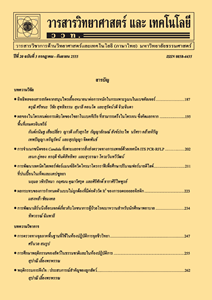ฤทธิ์ยับยั้งแอลฟากลูโคซิเดสและอะไมเลสของสารเซซามินและเซซาโมลินที่แยกจากน้ำมันงา
Main Article Content
Abstract
The percentage yield of lignans from sesame oil was 6.85 % and lignans were composed of a mixture of 2 compounds, which were then purified by column chromatography. These compounds were structurally elucidated as sesamin and sesamolin by nuclear magnetic resonance (NMR) spectroscopy technique. The α-glucosidase and amylase inhibitory activities of sesamin and sesamolin were tested. The results showed that sesamin and sesamolin at 0.5 mg/mL inhibited 80.34±1.22 and 56.76±4.62 % of α-glucosidase activity, respectively, as well as 76.63±1.11 and 43.30±5.76 % of amylase activity, respectively. Therefore, lignans were effective in inhibiting both enzyme activities. This study provided important information on promising compounds for developments of antidiabetic drugs.
Article Details
References
[2] Orhan, N., Hocbac, S., Orhan, D.D., Asian, M. and Ergun, F., 2014, Enzyme inhibitory and radical scavenging effects of some antidiabetic plants of Turkey, Iran J. Basic Med. Sci. 17: 426-432.
[3] Derosa, G. and Maffioli, P., 2012, alpha-Glucosidase inhibitors and their use in clinical practice, Arch. Med. Sci. 8: 899-906.
[4] de Melo, E.B., da Silveira Gomes, A. and Carvalho, I., 2006, α- and β-Glucosidase inhibitors: Chemical structure and biological activity, Tetrahedron 62: 10277-10302.
[5] Ramadhan, R. and Phuwapraisirisan, P., 2015, Arylalkanones from Horsfieldia macrobotrys are effective antidiabetic agents achieved by α-glucosidase inhibition and radical scavenging, Nat. Prod. Commun. 10: 325-328.
[6] Kiso, Y., 2004, Antioxidative roles of sesamin, a functional lignan in sesame seed, and it’ s effect on lipid- and alcohol-metabolism in the liver: A DNA microarray study, Biofactors 21: 191-196.
[7] Liu, Z., Law, W.K., Wang, D., Nie, X., Sheng, D., Song, G., Guo, K., Wei, P., Ouyang, P., Wong, C.W. and Zhou, G.C., 2014, Syn thesis and discovery of andrographolide derivatives as non-steroidal farnesoid X receptor (FXR) antagonists, RSC Adv. 4: 13533-13545.
[8] Babu, G.V.R., Kavitha, J. and Subbaraju, G.V., 2001, Justicia lignans: Part 8 – Lignans from Justicia orbiculata Wall., Indian J. Chem. 40: 864-866.
[9] Moazzami, A.A., Andersson, R.E. and Kamal-Eldin, A., 2007, Quantitative NMR analysis of a sesamin catechol metabolite in human urine, J. Nutr. 137: 940-944.
[10] Hsieh, T.J., Lu, L.H. and Su, C.C., 2005, NMR spectroscopic, mass spectroscopic, X-ray crystallographic, and theoretical studies of molecular mechanics of natural products: Farformolide B and sesamin, Biophys. Chem. 114: 13-20.
[11] Wikul, A., Damsud, T., Kataoka, K. and Phuwapraisirisan, P., 2012, (+)-Pinoresinol is a putative hypoglycemic agent in defatted sesame (Sesamum indicum) seeds though inhibiting alpha-glucosidase, Bioorg. Med. Chem. Lett. 22: 5215-5217.
[12] Damsud, T., Grace, M.H., Adisakwattana, S. and Phuwapraisirisan, P., 2014, Orthosiphol A from the aerial parts of Orthosiphon aristatus is putatively responsible for hypoglycemic effect via alpha-glucosidase inhibition, Nat. Prod. Commun. 9: 639-641.
[13] Reshma, M.V., Namitha, L.K., Sundaresan, A. and Ravi Kiran, C., 2013, Total phenol content, antioxidant activities and α-glucosidase inhibition of sesame cake extracts, J. Food Biochem. 37: 723-731.


